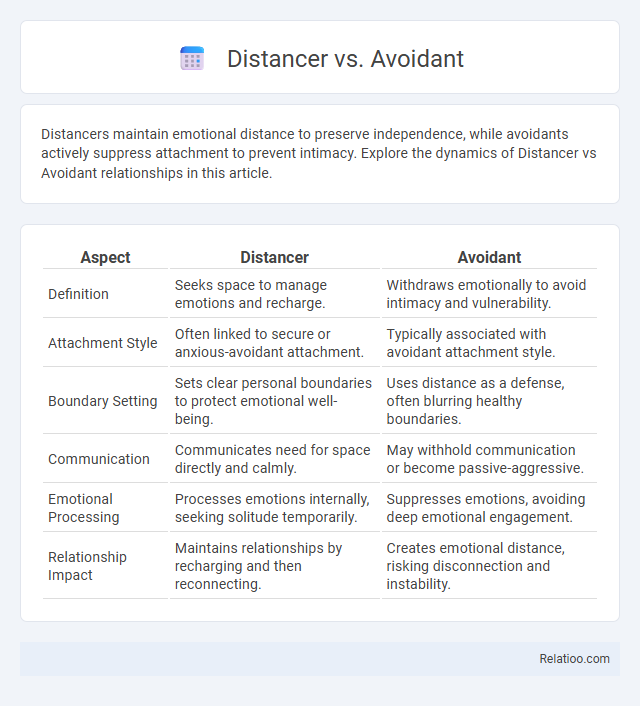Distancers maintain emotional distance to preserve independence, while avoidants actively suppress attachment to prevent intimacy. Explore the dynamics of Distancer vs Avoidant relationships in this article.
Table of Comparison
| Aspect | Distancer | Avoidant |
|---|---|---|
| Definition | Seeks space to manage emotions and recharge. | Withdraws emotionally to avoid intimacy and vulnerability. |
| Attachment Style | Often linked to secure or anxious-avoidant attachment. | Typically associated with avoidant attachment style. |
| Boundary Setting | Sets clear personal boundaries to protect emotional well-being. | Uses distance as a defense, often blurring healthy boundaries. |
| Communication | Communicates need for space directly and calmly. | May withhold communication or become passive-aggressive. |
| Emotional Processing | Processes emotions internally, seeking solitude temporarily. | Suppresses emotions, avoiding deep emotional engagement. |
| Relationship Impact | Maintains relationships by recharging and then reconnecting. | Creates emotional distance, risking disconnection and instability. |
Understanding the Concepts: Distancer vs Avoidant
Distancer and Avoidant attachment styles both involve emotional withdrawal, but distancers tend to seek space to maintain independence and manage stress, whereas avoidants typically suppress emotional needs to avoid intimacy. Understanding these differences helps you recognize that distancers value autonomy, while avoidants fear vulnerability, impacting relationship dynamics. Identifying your attachment tendencies can improve communication and foster healthier emotional connections.
Psychological Roots of Distancing and Avoidance
Distancing and avoidant behaviors in relationships often stem from deep psychological roots, such as attachment insecurities formed during early childhood experiences. Distancers, typically characterized by a desire for emotional independence, develop avoidance strategies to protect themselves from perceived threats of intimacy or vulnerability. Avoidants manifest as individuals who suppress emotional closeness due to fears of rejection or abandonment, influenced by insecure attachment patterns and past relational traumas.
Key Behavioral Differences Between Distancers and Avoidants
Distancers exhibit emotional withdrawal and prefer physical or psychological space during conflicts, seeking independence to maintain control, while avoidants generally suppress emotions and avoid intimacy due to fear of vulnerability. Distancers are more likely to use silence or distraction as coping mechanisms, whereas avoidants might downplay relationship importance or deny problems altogether. Understanding these behavioral differences is crucial for addressing communication patterns and fostering healthier relationships.
Emotional Patterns in Distancers and Avoidants
Distancers exhibit emotional patterns characterized by a need for space and self-reliance, often withdrawing from intimacy to maintain emotional control, while avoidants showcase fear of closeness and discomfort with dependency, frequently suppressing feelings to prevent vulnerability. Both types engage in emotional distancing, but distancers actively seek separation as a coping mechanism, whereas avoidants avoid emotional engagement due to anxiety about rejection. Understanding these distinct emotional patterns helps clarify their relational dynamics and challenges in forming secure attachments.
Communication Styles: Distancer vs Avoidant
Distancers maintain emotional distance by withdrawing during conflicts, often using silence as a form of self-protection, while avoidants tend to evade emotional intimacy altogether, showing discomfort with closeness and often minimizing issues. Your communication style as a distancer may involve indirect messages and subtle cues to create space, whereas avoidant individuals may explicitly change topics or physically remove themselves to prevent vulnerability. Understanding these distinct patterns can improve your ability to navigate and respond to relational tensions effectively.
Impact on Romantic Relationships
Distancer attachment styles often lead to emotional withdrawal, causing partners to feel neglected or unappreciated, which strains intimacy and trust. Avoidant individuals prioritize independence, frequently suppressing emotional needs and creating barriers that hinder deep connection and effective communication. The distancer-avoidant dynamic typically results in cycles of pursuit and withdrawal, increasing relational instability and dissatisfaction.
Triggers for Distancing and Avoidant Behaviors
Triggers for distancing in relationships often include fear of intimacy, past trauma, or feeling overwhelmed by emotional demands, leading individuals to withdraw to protect themselves. Avoidant behaviors are commonly triggered by perceived threats to independence, fear of rejection, or discomfort with vulnerability, causing a person to emotionally shut down or create space. Understanding these triggers can help you navigate and address the underlying causes of distancing and avoidant patterns in your relationships.
Overcoming Challenges: Healing Strategies
Overcoming challenges with Distancer and Avoidant attachment styles requires recognizing emotional withdrawal patterns and cultivating open communication to rebuild trust. Your healing strategy involves mindful vulnerability and consistent reassurance to bridge the gap caused by distancing behaviors. Developing empathy and setting healthy boundaries creates a foundation for emotional connection and long-term relationship growth.
Supporting Partners with Distancer or Avoidant Traits
Supporting partners with distancer or avoidant traits requires understanding their need for space and emotional self-protection. You can foster trust by respecting boundaries, practicing patience, and encouraging open communication without pressure. Recognizing patterns like emotional withdrawal or reluctance to discuss feelings helps you respond empathetically and strengthen the relationship.
Seeking Professional Help: Therapy Approaches
Seeking professional help for Distancer and Avoidant attachment styles often involves therapy approaches such as cognitive-behavioral therapy (CBT) and emotionally focused therapy (EFT) to address underlying fears of intimacy and abandonment. Therapists utilize techniques that promote emotional regulation, improve communication skills, and foster secure attachment patterns by helping clients confront avoidance behaviors and build vulnerability. Tailored interventions focus on increasing self-awareness and interpersonal connection, encouraging progress toward healthy relational dynamics.

Infographic: Distancer vs Avoidant
 relatioo.com
relatioo.com